Impact of Personal and Interpersonal Communication Skills
VerifiedAdded on 2023/06/05
|9
|2150
|389
Report
AI Summary
This report discusses the critical role of communication in organizations, emphasizing the significance of personal and interpersonal skills for effective leadership and employee performance. It highlights how effective communication fosters clarity, motivation, and productivity, while poor communication leads to misunderstandings and decreased performance. The report differentiates between hard and soft communication skills, with soft skills being closely tied to interpersonal competence, which is essential for building strong professional relationships. Furthermore, it explores strategies for leaders to persuade and influence employees through effective communication, emphasizing the importance of understanding individual perspectives, emotional intelligence, and integrity. The report concludes that mastering interpersonal skills is crucial for leaders to achieve organizational goals by fostering a positive and productive work environment.
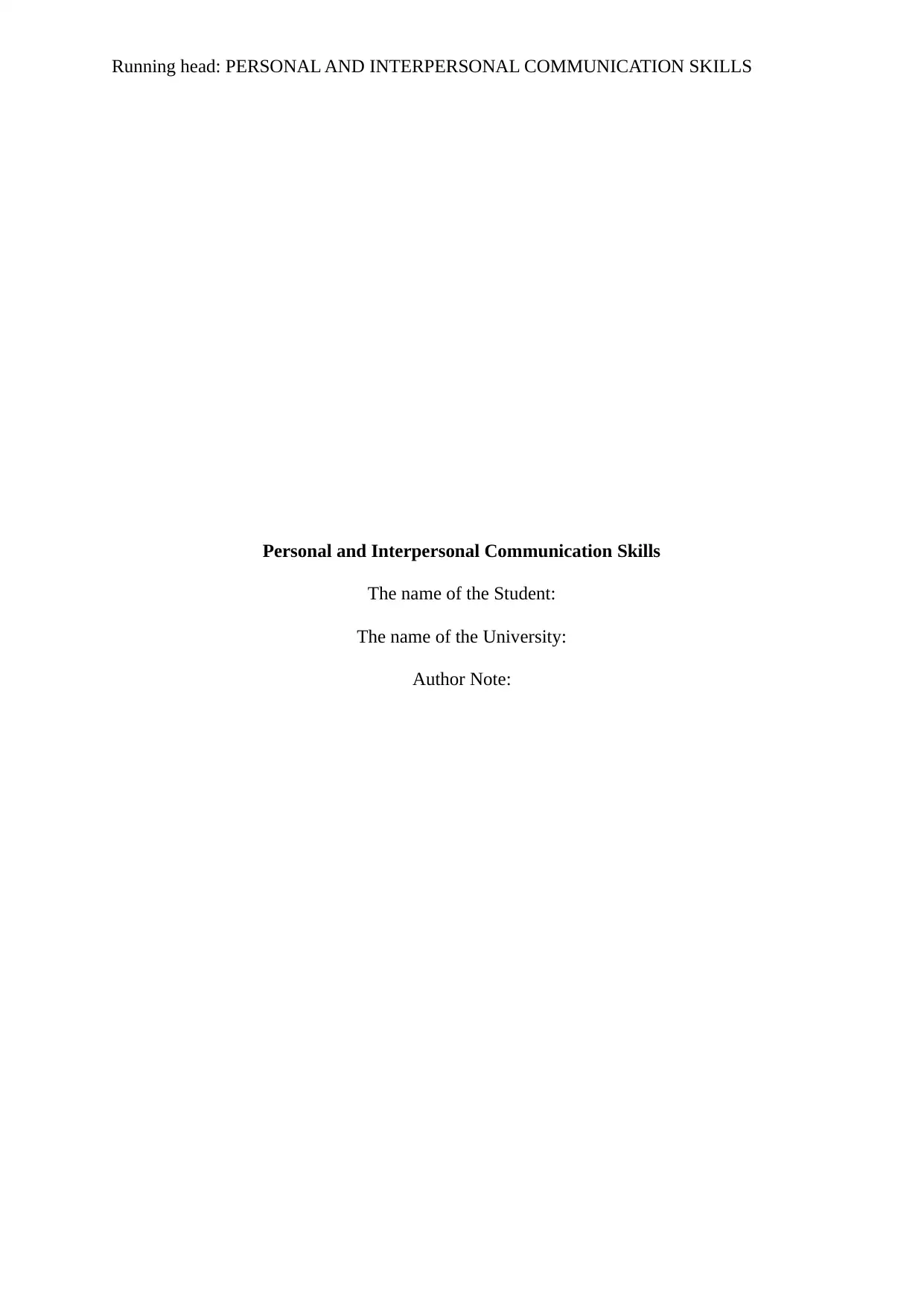
Running head: PERSONAL AND INTERPERSONAL COMMUNICATION SKILLS
Personal and Interpersonal Communication Skills
The name of the Student:
The name of the University:
Author Note:
Personal and Interpersonal Communication Skills
The name of the Student:
The name of the University:
Author Note:
Paraphrase This Document
Need a fresh take? Get an instant paraphrase of this document with our AI Paraphraser
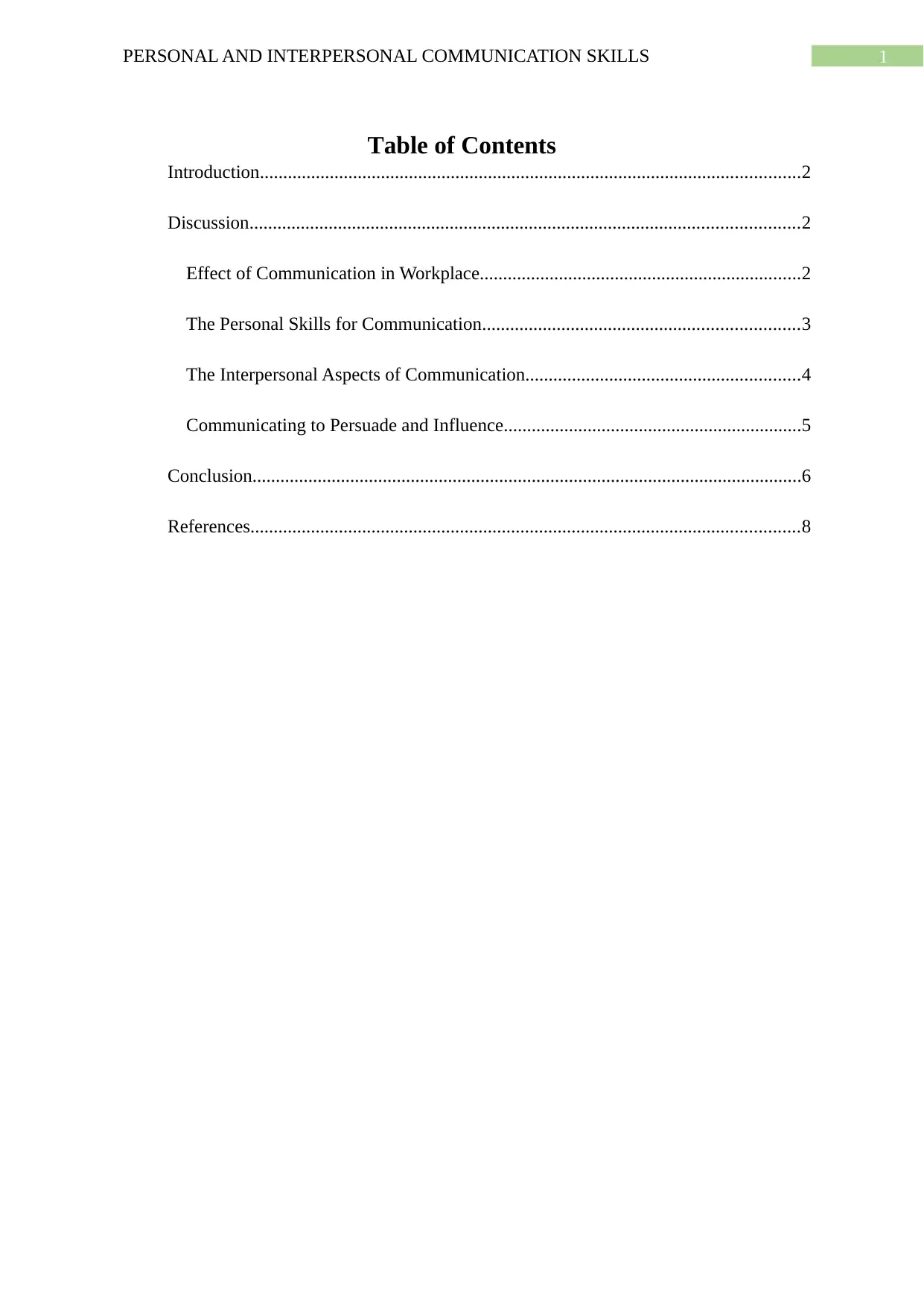
1PERSONAL AND INTERPERSONAL COMMUNICATION SKILLS
Table of Contents
Introduction....................................................................................................................2
Discussion......................................................................................................................2
Effect of Communication in Workplace.....................................................................2
The Personal Skills for Communication....................................................................3
The Interpersonal Aspects of Communication...........................................................4
Communicating to Persuade and Influence................................................................5
Conclusion......................................................................................................................6
References......................................................................................................................8
Table of Contents
Introduction....................................................................................................................2
Discussion......................................................................................................................2
Effect of Communication in Workplace.....................................................................2
The Personal Skills for Communication....................................................................3
The Interpersonal Aspects of Communication...........................................................4
Communicating to Persuade and Influence................................................................5
Conclusion......................................................................................................................6
References......................................................................................................................8
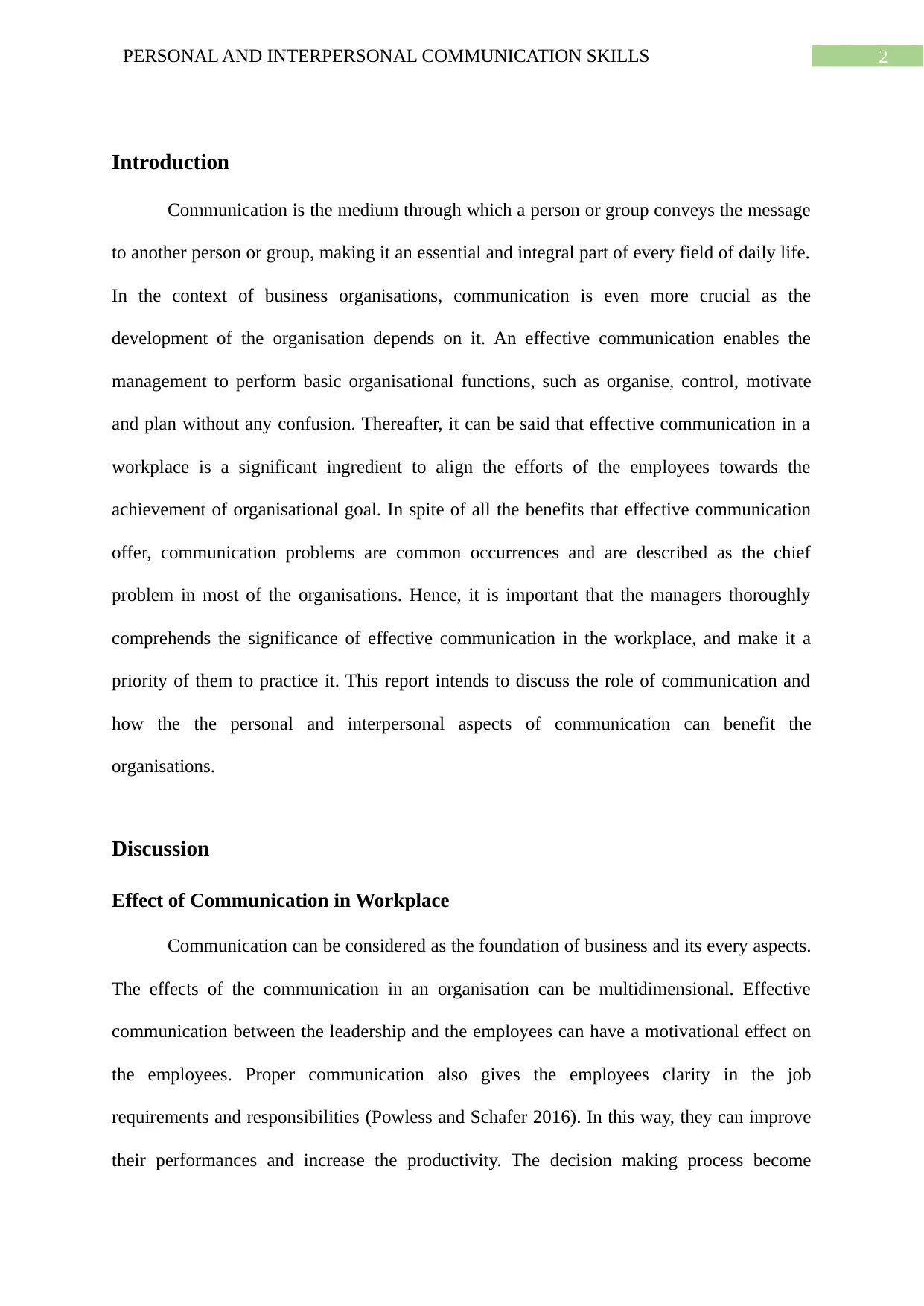
2PERSONAL AND INTERPERSONAL COMMUNICATION SKILLS
Introduction
Communication is the medium through which a person or group conveys the message
to another person or group, making it an essential and integral part of every field of daily life.
In the context of business organisations, communication is even more crucial as the
development of the organisation depends on it. An effective communication enables the
management to perform basic organisational functions, such as organise, control, motivate
and plan without any confusion. Thereafter, it can be said that effective communication in a
workplace is a significant ingredient to align the efforts of the employees towards the
achievement of organisational goal. In spite of all the benefits that effective communication
offer, communication problems are common occurrences and are described as the chief
problem in most of the organisations. Hence, it is important that the managers thoroughly
comprehends the significance of effective communication in the workplace, and make it a
priority of them to practice it. This report intends to discuss the role of communication and
how the the personal and interpersonal aspects of communication can benefit the
organisations.
Discussion
Effect of Communication in Workplace
Communication can be considered as the foundation of business and its every aspects.
The effects of the communication in an organisation can be multidimensional. Effective
communication between the leadership and the employees can have a motivational effect on
the employees. Proper communication also gives the employees clarity in the job
requirements and responsibilities (Powless and Schafer 2016). In this way, they can improve
their performances and increase the productivity. The decision making process become
Introduction
Communication is the medium through which a person or group conveys the message
to another person or group, making it an essential and integral part of every field of daily life.
In the context of business organisations, communication is even more crucial as the
development of the organisation depends on it. An effective communication enables the
management to perform basic organisational functions, such as organise, control, motivate
and plan without any confusion. Thereafter, it can be said that effective communication in a
workplace is a significant ingredient to align the efforts of the employees towards the
achievement of organisational goal. In spite of all the benefits that effective communication
offer, communication problems are common occurrences and are described as the chief
problem in most of the organisations. Hence, it is important that the managers thoroughly
comprehends the significance of effective communication in the workplace, and make it a
priority of them to practice it. This report intends to discuss the role of communication and
how the the personal and interpersonal aspects of communication can benefit the
organisations.
Discussion
Effect of Communication in Workplace
Communication can be considered as the foundation of business and its every aspects.
The effects of the communication in an organisation can be multidimensional. Effective
communication between the leadership and the employees can have a motivational effect on
the employees. Proper communication also gives the employees clarity in the job
requirements and responsibilities (Powless and Schafer 2016). In this way, they can improve
their performances and increase the productivity. The decision making process become
⊘ This is a preview!⊘
Do you want full access?
Subscribe today to unlock all pages.

Trusted by 1+ million students worldwide
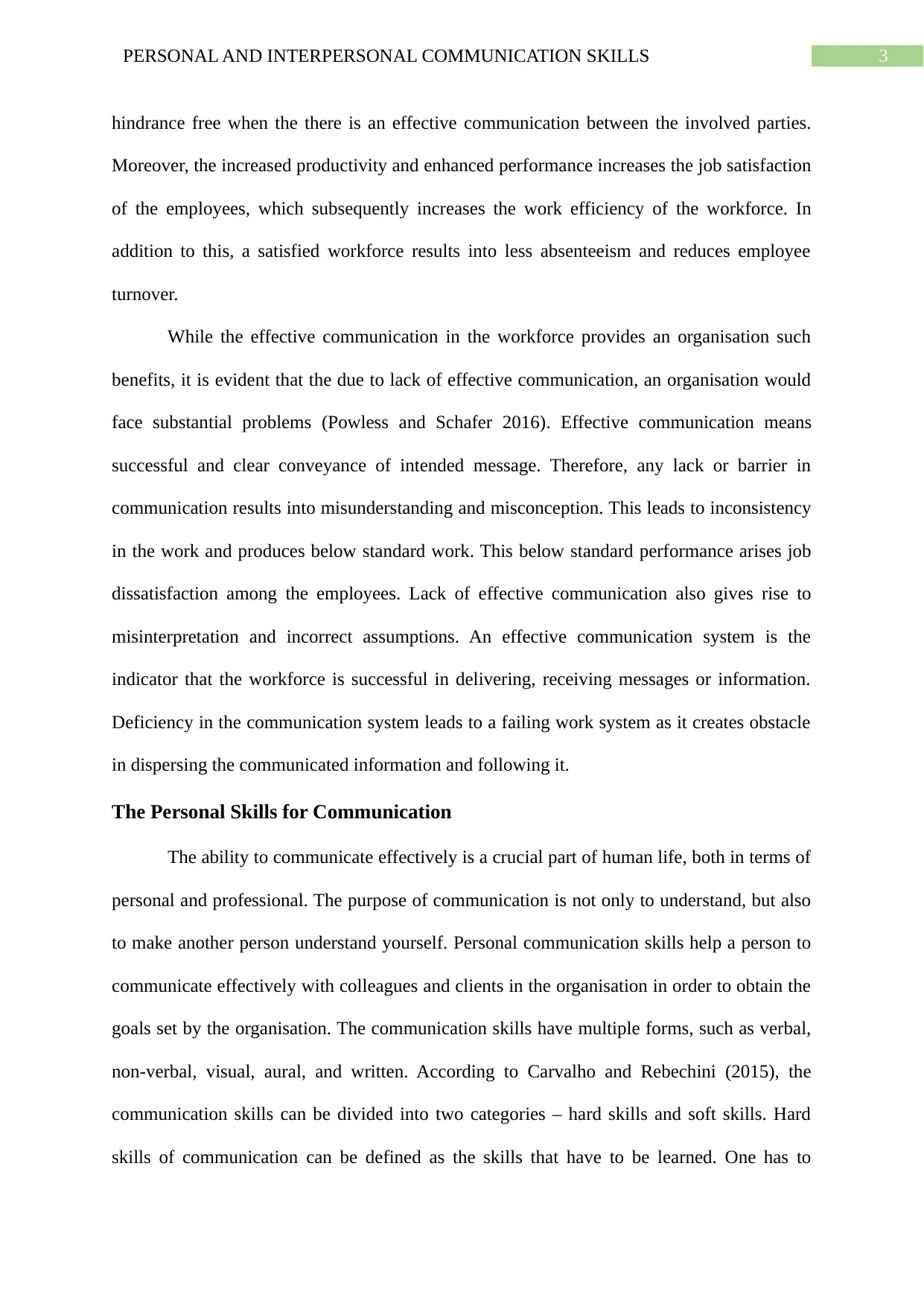
3PERSONAL AND INTERPERSONAL COMMUNICATION SKILLS
hindrance free when the there is an effective communication between the involved parties.
Moreover, the increased productivity and enhanced performance increases the job satisfaction
of the employees, which subsequently increases the work efficiency of the workforce. In
addition to this, a satisfied workforce results into less absenteeism and reduces employee
turnover.
While the effective communication in the workforce provides an organisation such
benefits, it is evident that the due to lack of effective communication, an organisation would
face substantial problems (Powless and Schafer 2016). Effective communication means
successful and clear conveyance of intended message. Therefore, any lack or barrier in
communication results into misunderstanding and misconception. This leads to inconsistency
in the work and produces below standard work. This below standard performance arises job
dissatisfaction among the employees. Lack of effective communication also gives rise to
misinterpretation and incorrect assumptions. An effective communication system is the
indicator that the workforce is successful in delivering, receiving messages or information.
Deficiency in the communication system leads to a failing work system as it creates obstacle
in dispersing the communicated information and following it.
The Personal Skills for Communication
The ability to communicate effectively is a crucial part of human life, both in terms of
personal and professional. The purpose of communication is not only to understand, but also
to make another person understand yourself. Personal communication skills help a person to
communicate effectively with colleagues and clients in the organisation in order to obtain the
goals set by the organisation. The communication skills have multiple forms, such as verbal,
non-verbal, visual, aural, and written. According to Carvalho and Rebechini (2015), the
communication skills can be divided into two categories – hard skills and soft skills. Hard
skills of communication can be defined as the skills that have to be learned. One has to
hindrance free when the there is an effective communication between the involved parties.
Moreover, the increased productivity and enhanced performance increases the job satisfaction
of the employees, which subsequently increases the work efficiency of the workforce. In
addition to this, a satisfied workforce results into less absenteeism and reduces employee
turnover.
While the effective communication in the workforce provides an organisation such
benefits, it is evident that the due to lack of effective communication, an organisation would
face substantial problems (Powless and Schafer 2016). Effective communication means
successful and clear conveyance of intended message. Therefore, any lack or barrier in
communication results into misunderstanding and misconception. This leads to inconsistency
in the work and produces below standard work. This below standard performance arises job
dissatisfaction among the employees. Lack of effective communication also gives rise to
misinterpretation and incorrect assumptions. An effective communication system is the
indicator that the workforce is successful in delivering, receiving messages or information.
Deficiency in the communication system leads to a failing work system as it creates obstacle
in dispersing the communicated information and following it.
The Personal Skills for Communication
The ability to communicate effectively is a crucial part of human life, both in terms of
personal and professional. The purpose of communication is not only to understand, but also
to make another person understand yourself. Personal communication skills help a person to
communicate effectively with colleagues and clients in the organisation in order to obtain the
goals set by the organisation. The communication skills have multiple forms, such as verbal,
non-verbal, visual, aural, and written. According to Carvalho and Rebechini (2015), the
communication skills can be divided into two categories – hard skills and soft skills. Hard
skills of communication can be defined as the skills that have to be learned. One has to
Paraphrase This Document
Need a fresh take? Get an instant paraphrase of this document with our AI Paraphraser
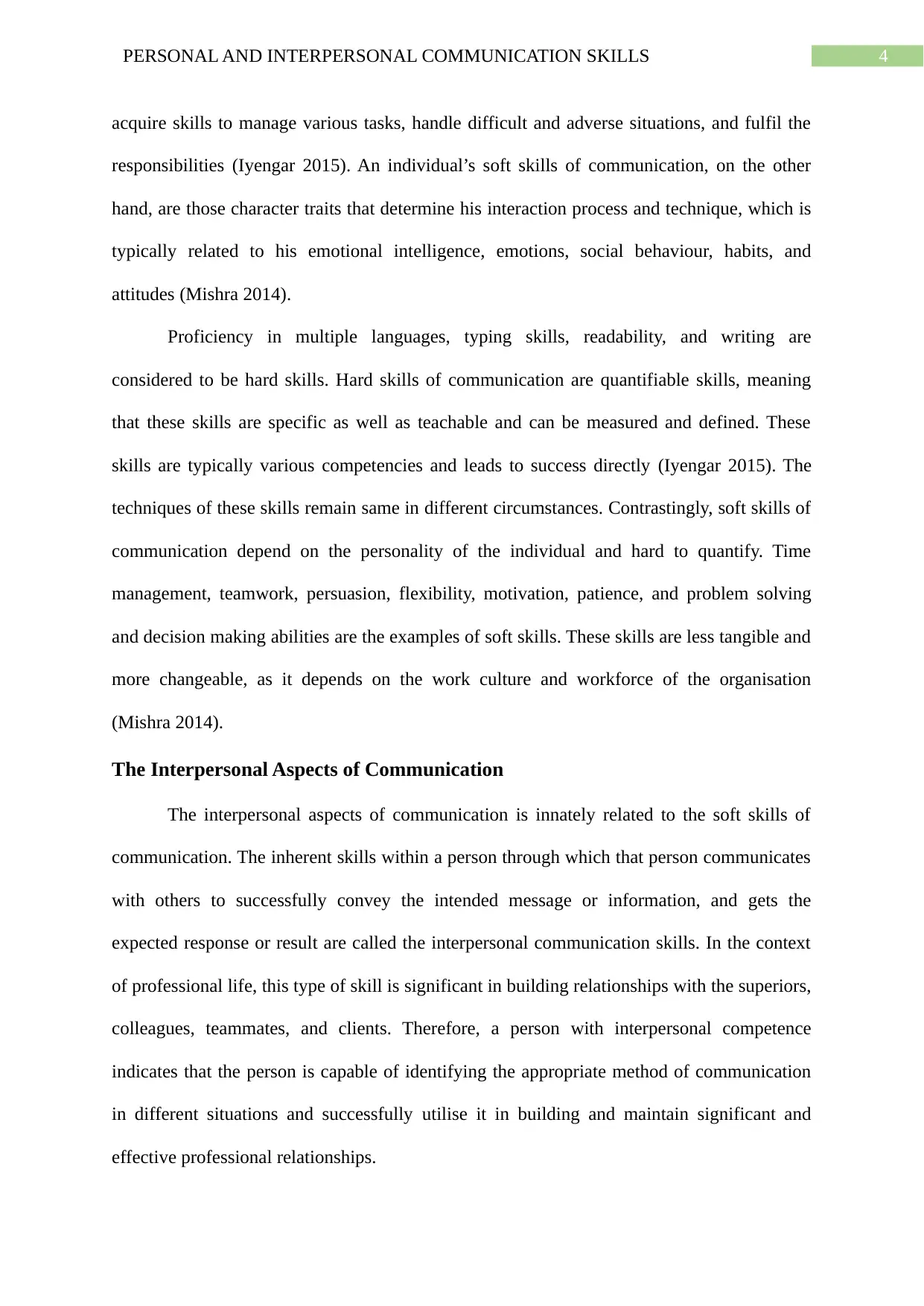
4PERSONAL AND INTERPERSONAL COMMUNICATION SKILLS
acquire skills to manage various tasks, handle difficult and adverse situations, and fulfil the
responsibilities (Iyengar 2015). An individual’s soft skills of communication, on the other
hand, are those character traits that determine his interaction process and technique, which is
typically related to his emotional intelligence, emotions, social behaviour, habits, and
attitudes (Mishra 2014).
Proficiency in multiple languages, typing skills, readability, and writing are
considered to be hard skills. Hard skills of communication are quantifiable skills, meaning
that these skills are specific as well as teachable and can be measured and defined. These
skills are typically various competencies and leads to success directly (Iyengar 2015). The
techniques of these skills remain same in different circumstances. Contrastingly, soft skills of
communication depend on the personality of the individual and hard to quantify. Time
management, teamwork, persuasion, flexibility, motivation, patience, and problem solving
and decision making abilities are the examples of soft skills. These skills are less tangible and
more changeable, as it depends on the work culture and workforce of the organisation
(Mishra 2014).
The Interpersonal Aspects of Communication
The interpersonal aspects of communication is innately related to the soft skills of
communication. The inherent skills within a person through which that person communicates
with others to successfully convey the intended message or information, and gets the
expected response or result are called the interpersonal communication skills. In the context
of professional life, this type of skill is significant in building relationships with the superiors,
colleagues, teammates, and clients. Therefore, a person with interpersonal competence
indicates that the person is capable of identifying the appropriate method of communication
in different situations and successfully utilise it in building and maintain significant and
effective professional relationships.
acquire skills to manage various tasks, handle difficult and adverse situations, and fulfil the
responsibilities (Iyengar 2015). An individual’s soft skills of communication, on the other
hand, are those character traits that determine his interaction process and technique, which is
typically related to his emotional intelligence, emotions, social behaviour, habits, and
attitudes (Mishra 2014).
Proficiency in multiple languages, typing skills, readability, and writing are
considered to be hard skills. Hard skills of communication are quantifiable skills, meaning
that these skills are specific as well as teachable and can be measured and defined. These
skills are typically various competencies and leads to success directly (Iyengar 2015). The
techniques of these skills remain same in different circumstances. Contrastingly, soft skills of
communication depend on the personality of the individual and hard to quantify. Time
management, teamwork, persuasion, flexibility, motivation, patience, and problem solving
and decision making abilities are the examples of soft skills. These skills are less tangible and
more changeable, as it depends on the work culture and workforce of the organisation
(Mishra 2014).
The Interpersonal Aspects of Communication
The interpersonal aspects of communication is innately related to the soft skills of
communication. The inherent skills within a person through which that person communicates
with others to successfully convey the intended message or information, and gets the
expected response or result are called the interpersonal communication skills. In the context
of professional life, this type of skill is significant in building relationships with the superiors,
colleagues, teammates, and clients. Therefore, a person with interpersonal competence
indicates that the person is capable of identifying the appropriate method of communication
in different situations and successfully utilise it in building and maintain significant and
effective professional relationships.
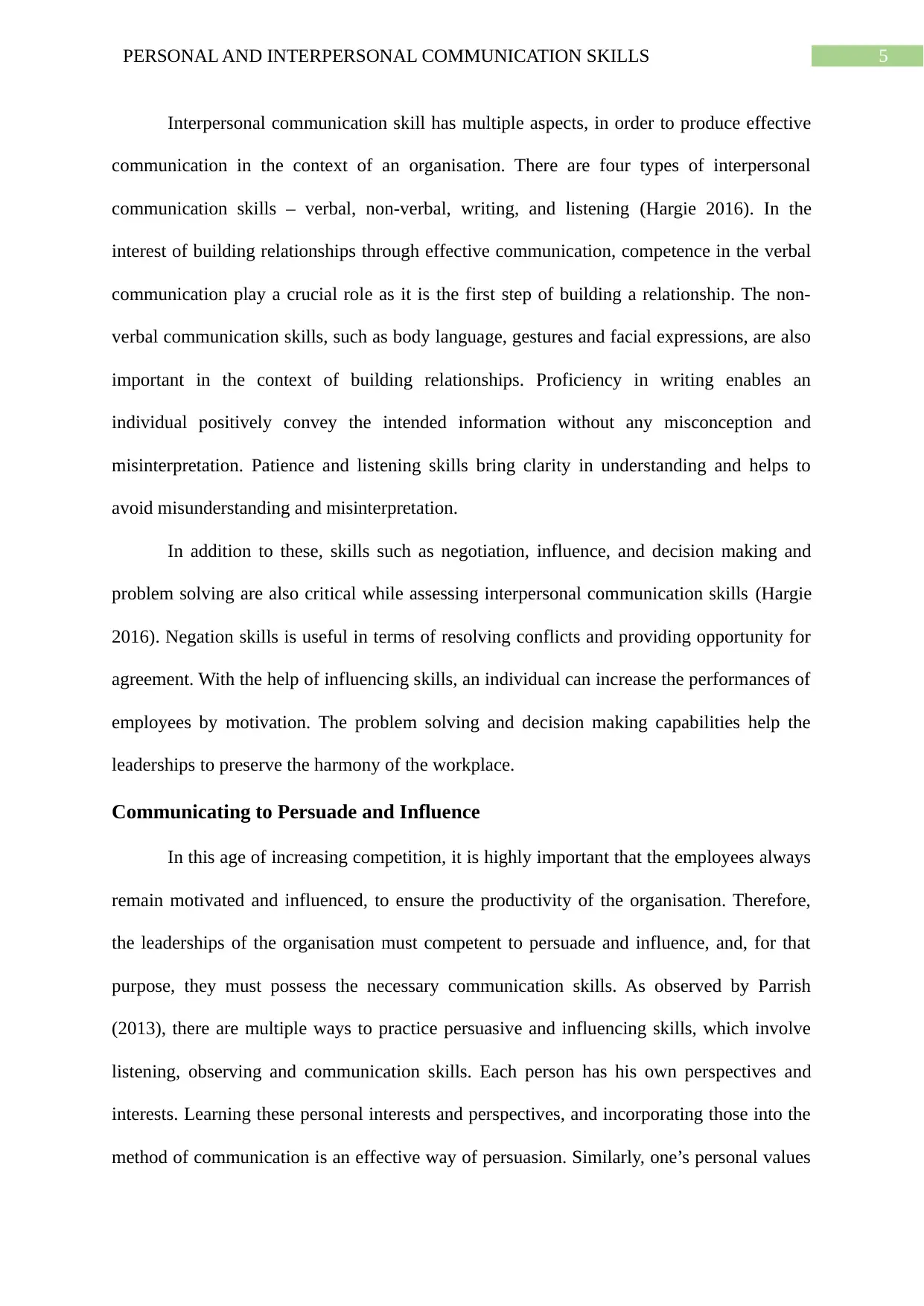
5PERSONAL AND INTERPERSONAL COMMUNICATION SKILLS
Interpersonal communication skill has multiple aspects, in order to produce effective
communication in the context of an organisation. There are four types of interpersonal
communication skills – verbal, non-verbal, writing, and listening (Hargie 2016). In the
interest of building relationships through effective communication, competence in the verbal
communication play a crucial role as it is the first step of building a relationship. The non-
verbal communication skills, such as body language, gestures and facial expressions, are also
important in the context of building relationships. Proficiency in writing enables an
individual positively convey the intended information without any misconception and
misinterpretation. Patience and listening skills bring clarity in understanding and helps to
avoid misunderstanding and misinterpretation.
In addition to these, skills such as negotiation, influence, and decision making and
problem solving are also critical while assessing interpersonal communication skills (Hargie
2016). Negation skills is useful in terms of resolving conflicts and providing opportunity for
agreement. With the help of influencing skills, an individual can increase the performances of
employees by motivation. The problem solving and decision making capabilities help the
leaderships to preserve the harmony of the workplace.
Communicating to Persuade and Influence
In this age of increasing competition, it is highly important that the employees always
remain motivated and influenced, to ensure the productivity of the organisation. Therefore,
the leaderships of the organisation must competent to persuade and influence, and, for that
purpose, they must possess the necessary communication skills. As observed by Parrish
(2013), there are multiple ways to practice persuasive and influencing skills, which involve
listening, observing and communication skills. Each person has his own perspectives and
interests. Learning these personal interests and perspectives, and incorporating those into the
method of communication is an effective way of persuasion. Similarly, one’s personal values
Interpersonal communication skill has multiple aspects, in order to produce effective
communication in the context of an organisation. There are four types of interpersonal
communication skills – verbal, non-verbal, writing, and listening (Hargie 2016). In the
interest of building relationships through effective communication, competence in the verbal
communication play a crucial role as it is the first step of building a relationship. The non-
verbal communication skills, such as body language, gestures and facial expressions, are also
important in the context of building relationships. Proficiency in writing enables an
individual positively convey the intended information without any misconception and
misinterpretation. Patience and listening skills bring clarity in understanding and helps to
avoid misunderstanding and misinterpretation.
In addition to these, skills such as negotiation, influence, and decision making and
problem solving are also critical while assessing interpersonal communication skills (Hargie
2016). Negation skills is useful in terms of resolving conflicts and providing opportunity for
agreement. With the help of influencing skills, an individual can increase the performances of
employees by motivation. The problem solving and decision making capabilities help the
leaderships to preserve the harmony of the workplace.
Communicating to Persuade and Influence
In this age of increasing competition, it is highly important that the employees always
remain motivated and influenced, to ensure the productivity of the organisation. Therefore,
the leaderships of the organisation must competent to persuade and influence, and, for that
purpose, they must possess the necessary communication skills. As observed by Parrish
(2013), there are multiple ways to practice persuasive and influencing skills, which involve
listening, observing and communication skills. Each person has his own perspectives and
interests. Learning these personal interests and perspectives, and incorporating those into the
method of communication is an effective way of persuasion. Similarly, one’s personal values
⊘ This is a preview!⊘
Do you want full access?
Subscribe today to unlock all pages.

Trusted by 1+ million students worldwide
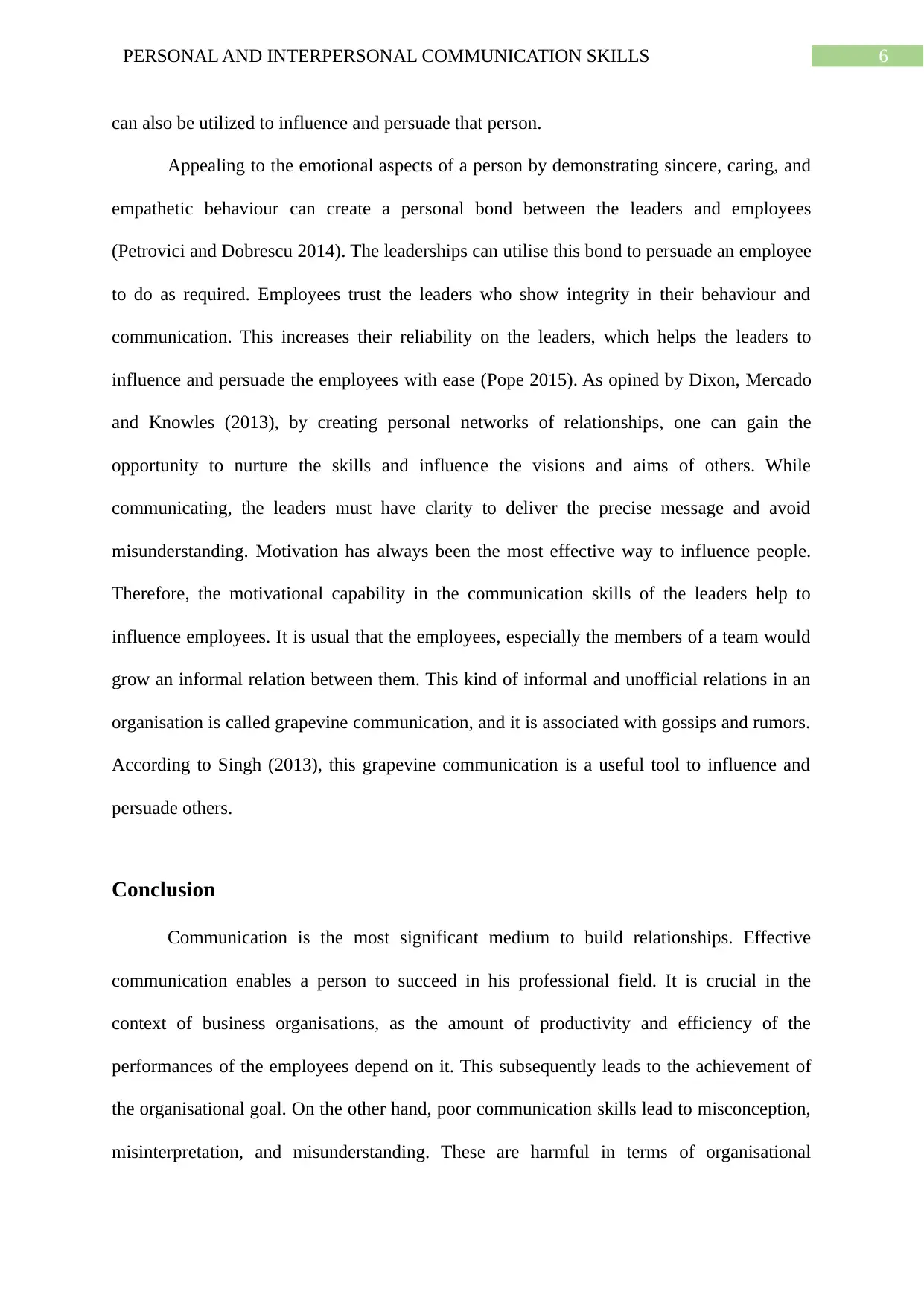
6PERSONAL AND INTERPERSONAL COMMUNICATION SKILLS
can also be utilized to influence and persuade that person.
Appealing to the emotional aspects of a person by demonstrating sincere, caring, and
empathetic behaviour can create a personal bond between the leaders and employees
(Petrovici and Dobrescu 2014). The leaderships can utilise this bond to persuade an employee
to do as required. Employees trust the leaders who show integrity in their behaviour and
communication. This increases their reliability on the leaders, which helps the leaders to
influence and persuade the employees with ease (Pope 2015). As opined by Dixon, Mercado
and Knowles (2013), by creating personal networks of relationships, one can gain the
opportunity to nurture the skills and influence the visions and aims of others. While
communicating, the leaders must have clarity to deliver the precise message and avoid
misunderstanding. Motivation has always been the most effective way to influence people.
Therefore, the motivational capability in the communication skills of the leaders help to
influence employees. It is usual that the employees, especially the members of a team would
grow an informal relation between them. This kind of informal and unofficial relations in an
organisation is called grapevine communication, and it is associated with gossips and rumors.
According to Singh (2013), this grapevine communication is a useful tool to influence and
persuade others.
Conclusion
Communication is the most significant medium to build relationships. Effective
communication enables a person to succeed in his professional field. It is crucial in the
context of business organisations, as the amount of productivity and efficiency of the
performances of the employees depend on it. This subsequently leads to the achievement of
the organisational goal. On the other hand, poor communication skills lead to misconception,
misinterpretation, and misunderstanding. These are harmful in terms of organisational
can also be utilized to influence and persuade that person.
Appealing to the emotional aspects of a person by demonstrating sincere, caring, and
empathetic behaviour can create a personal bond between the leaders and employees
(Petrovici and Dobrescu 2014). The leaderships can utilise this bond to persuade an employee
to do as required. Employees trust the leaders who show integrity in their behaviour and
communication. This increases their reliability on the leaders, which helps the leaders to
influence and persuade the employees with ease (Pope 2015). As opined by Dixon, Mercado
and Knowles (2013), by creating personal networks of relationships, one can gain the
opportunity to nurture the skills and influence the visions and aims of others. While
communicating, the leaders must have clarity to deliver the precise message and avoid
misunderstanding. Motivation has always been the most effective way to influence people.
Therefore, the motivational capability in the communication skills of the leaders help to
influence employees. It is usual that the employees, especially the members of a team would
grow an informal relation between them. This kind of informal and unofficial relations in an
organisation is called grapevine communication, and it is associated with gossips and rumors.
According to Singh (2013), this grapevine communication is a useful tool to influence and
persuade others.
Conclusion
Communication is the most significant medium to build relationships. Effective
communication enables a person to succeed in his professional field. It is crucial in the
context of business organisations, as the amount of productivity and efficiency of the
performances of the employees depend on it. This subsequently leads to the achievement of
the organisational goal. On the other hand, poor communication skills lead to misconception,
misinterpretation, and misunderstanding. These are harmful in terms of organisational
Paraphrase This Document
Need a fresh take? Get an instant paraphrase of this document with our AI Paraphraser
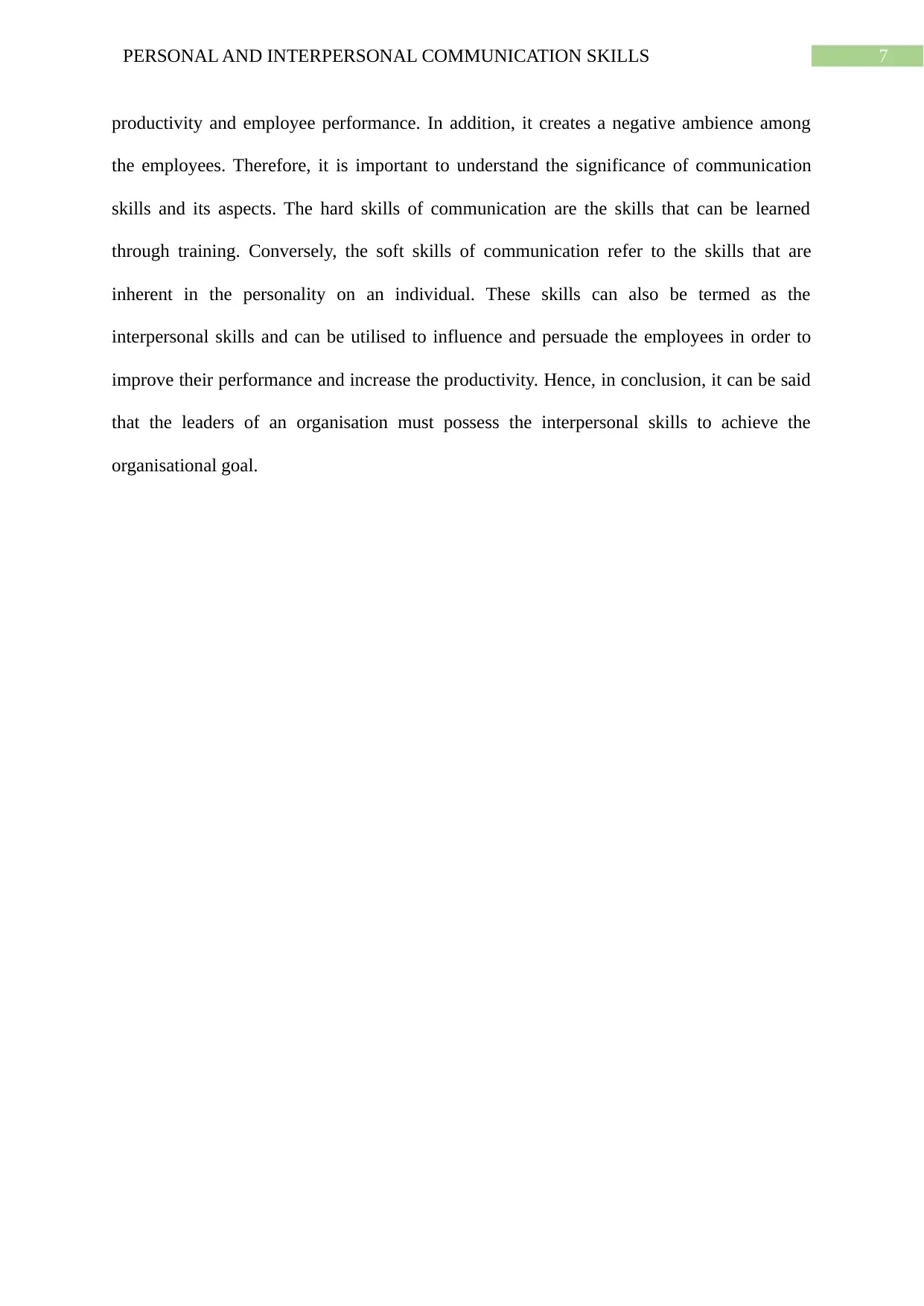
7PERSONAL AND INTERPERSONAL COMMUNICATION SKILLS
productivity and employee performance. In addition, it creates a negative ambience among
the employees. Therefore, it is important to understand the significance of communication
skills and its aspects. The hard skills of communication are the skills that can be learned
through training. Conversely, the soft skills of communication refer to the skills that are
inherent in the personality on an individual. These skills can also be termed as the
interpersonal skills and can be utilised to influence and persuade the employees in order to
improve their performance and increase the productivity. Hence, in conclusion, it can be said
that the leaders of an organisation must possess the interpersonal skills to achieve the
organisational goal.
productivity and employee performance. In addition, it creates a negative ambience among
the employees. Therefore, it is important to understand the significance of communication
skills and its aspects. The hard skills of communication are the skills that can be learned
through training. Conversely, the soft skills of communication refer to the skills that are
inherent in the personality on an individual. These skills can also be termed as the
interpersonal skills and can be utilised to influence and persuade the employees in order to
improve their performance and increase the productivity. Hence, in conclusion, it can be said
that the leaders of an organisation must possess the interpersonal skills to achieve the
organisational goal.
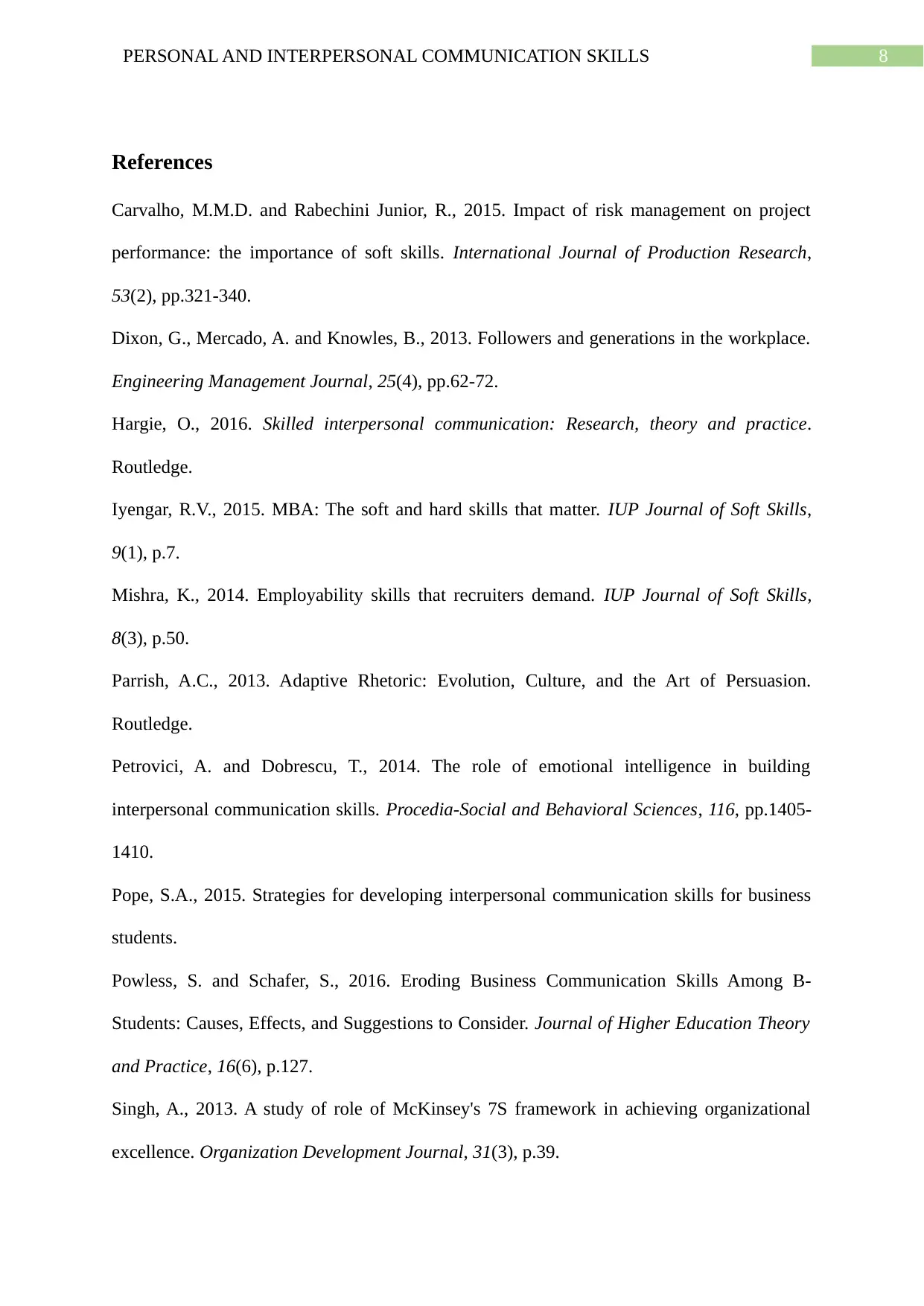
8PERSONAL AND INTERPERSONAL COMMUNICATION SKILLS
References
Carvalho, M.M.D. and Rabechini Junior, R., 2015. Impact of risk management on project
performance: the importance of soft skills. International Journal of Production Research,
53(2), pp.321-340.
Dixon, G., Mercado, A. and Knowles, B., 2013. Followers and generations in the workplace.
Engineering Management Journal, 25(4), pp.62-72.
Hargie, O., 2016. Skilled interpersonal communication: Research, theory and practice.
Routledge.
Iyengar, R.V., 2015. MBA: The soft and hard skills that matter. IUP Journal of Soft Skills,
9(1), p.7.
Mishra, K., 2014. Employability skills that recruiters demand. IUP Journal of Soft Skills,
8(3), p.50.
Parrish, A.C., 2013. Adaptive Rhetoric: Evolution, Culture, and the Art of Persuasion.
Routledge.
Petrovici, A. and Dobrescu, T., 2014. The role of emotional intelligence in building
interpersonal communication skills. Procedia-Social and Behavioral Sciences, 116, pp.1405-
1410.
Pope, S.A., 2015. Strategies for developing interpersonal communication skills for business
students.
Powless, S. and Schafer, S., 2016. Eroding Business Communication Skills Among B-
Students: Causes, Effects, and Suggestions to Consider. Journal of Higher Education Theory
and Practice, 16(6), p.127.
Singh, A., 2013. A study of role of McKinsey's 7S framework in achieving organizational
excellence. Organization Development Journal, 31(3), p.39.
References
Carvalho, M.M.D. and Rabechini Junior, R., 2015. Impact of risk management on project
performance: the importance of soft skills. International Journal of Production Research,
53(2), pp.321-340.
Dixon, G., Mercado, A. and Knowles, B., 2013. Followers and generations in the workplace.
Engineering Management Journal, 25(4), pp.62-72.
Hargie, O., 2016. Skilled interpersonal communication: Research, theory and practice.
Routledge.
Iyengar, R.V., 2015. MBA: The soft and hard skills that matter. IUP Journal of Soft Skills,
9(1), p.7.
Mishra, K., 2014. Employability skills that recruiters demand. IUP Journal of Soft Skills,
8(3), p.50.
Parrish, A.C., 2013. Adaptive Rhetoric: Evolution, Culture, and the Art of Persuasion.
Routledge.
Petrovici, A. and Dobrescu, T., 2014. The role of emotional intelligence in building
interpersonal communication skills. Procedia-Social and Behavioral Sciences, 116, pp.1405-
1410.
Pope, S.A., 2015. Strategies for developing interpersonal communication skills for business
students.
Powless, S. and Schafer, S., 2016. Eroding Business Communication Skills Among B-
Students: Causes, Effects, and Suggestions to Consider. Journal of Higher Education Theory
and Practice, 16(6), p.127.
Singh, A., 2013. A study of role of McKinsey's 7S framework in achieving organizational
excellence. Organization Development Journal, 31(3), p.39.
⊘ This is a preview!⊘
Do you want full access?
Subscribe today to unlock all pages.

Trusted by 1+ million students worldwide
1 out of 9
Related Documents
Your All-in-One AI-Powered Toolkit for Academic Success.
+13062052269
info@desklib.com
Available 24*7 on WhatsApp / Email
![[object Object]](/_next/static/media/star-bottom.7253800d.svg)
Unlock your academic potential
Copyright © 2020–2025 A2Z Services. All Rights Reserved. Developed and managed by ZUCOL.




